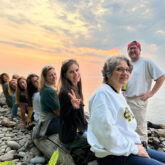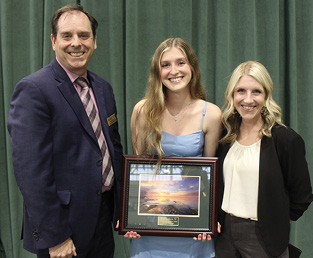 President Deborah F. Stanley, speaking at the Landmark Celebration of Rice Creek Field Station Oct. 3, 2013, said, “We gather at beautiful Rice Creek to rededicate our long-standing commitment to the environment on this 400-acre woodland site and to emphasize our increased commitment to research.”
President Deborah F. Stanley, speaking at the Landmark Celebration of Rice Creek Field Station Oct. 3, 2013, said, “We gather at beautiful Rice Creek to rededicate our long-standing commitment to the environment on this 400-acre woodland site and to emphasize our increased commitment to research.”

President Deborah F. Stanley planted a Northern White Oak tree to commemorate the dedication of Rice Creek Field Station. Visible in the background is the astronomical observatory, housing a new telescope that is available for public stargazing events and will be used for research projects conducted by students and faculty.
Celebrating the dedication, with a crowd of current and former faculty members, alumni, community residents and students, the president noted that the original field station had been implemented nearly half a century ago. The dream, design and planning stages for the new Rice Creek lasted almost a decade, culminating with the reopening in the fall 2013 semester.
The president emphasized the varied uses of the field station, saying, “This is a place where the wild things are. It is embedded in the community.” She highlighted the important nexus of fieldwork in the natural environment with the research and teaching opportunities availabile in the 7,640-square-foot facility, which is designed to achieve LEED Gold Certification.

Former professor of biology and first director of the Rice Creek Field Station John Weeks said he “had the itch that needed scratching” to establish a field station and nature center as part of the SUNY Oswego teaching/learning experience. He and other faculty members worked with students and Boy Scouts to forge trails on land acquired in the late 1950s, when Foster Brown was president. The facility opened in 1966. Weeks says when he was leading hikes, he wore a trademark hat with a long feather in it. “I’m not very tall,” he said, “so I always told people just to follow the feather.”
With its energy-efficient building, comprising well-equipped laboratories and classrooms, an observatory that houses a 16” Ritchey-Chretien-type reflecting telescope, and miles of trails providing access to varied terrain and habitats, Rice Creek Field Station is, Stanley says, “A place that brings the heavens and earth together.”
— Linda Loomis ’90 M ’97
You might also like
More from Campus Currents
University Celebrates Third Annual Founder’s Weekend
University Celebrates Third Annual Founder’s Weekend Several hundred members of the Laker community gathered together on campus to learn about the …
SAVAC Captain, Biology Major Named 2023 Outstanding Senior Award Winner
SAVAC Captain, Biology Major Named 2023 Outstanding Senior Award Winner Shannon Harris ’23, a biology major from Webster, N.Y., was selected …














